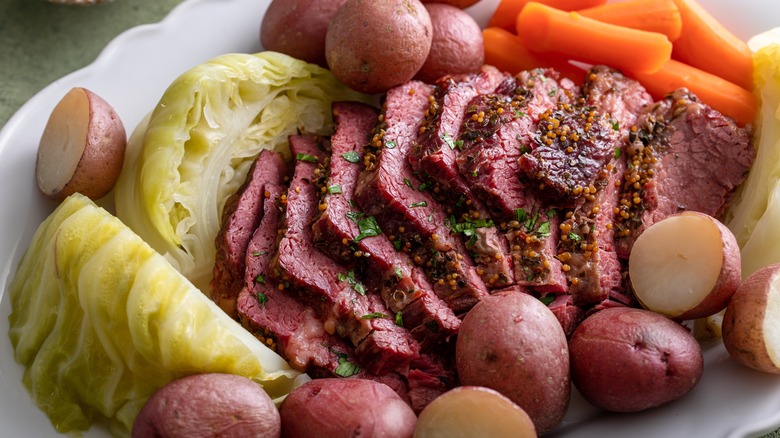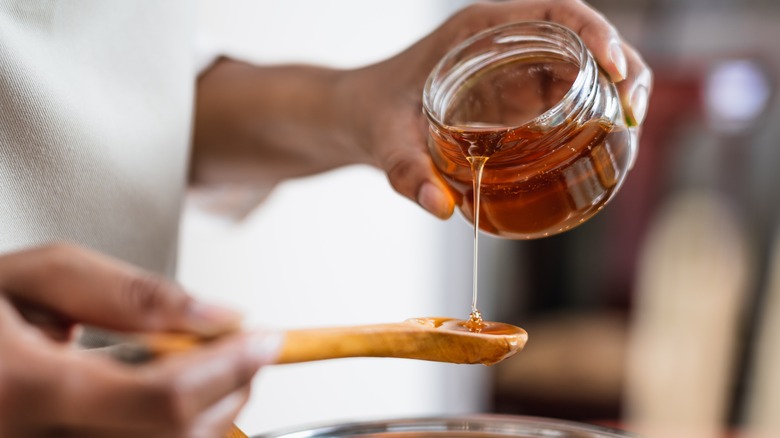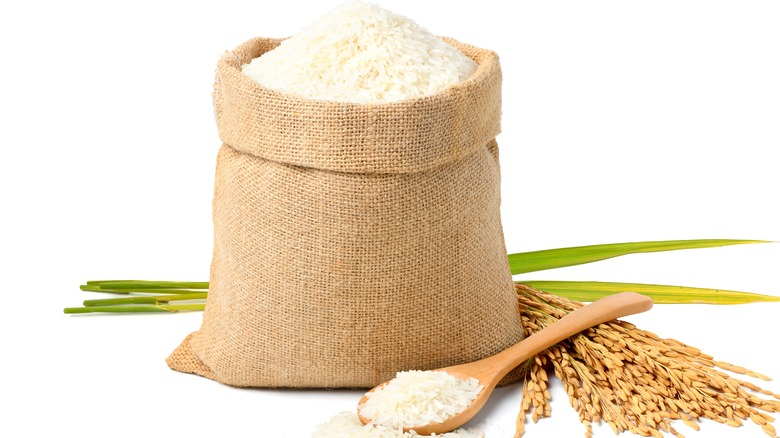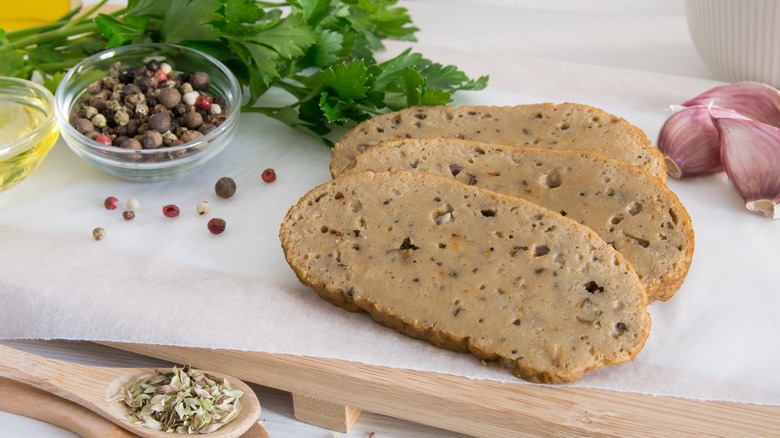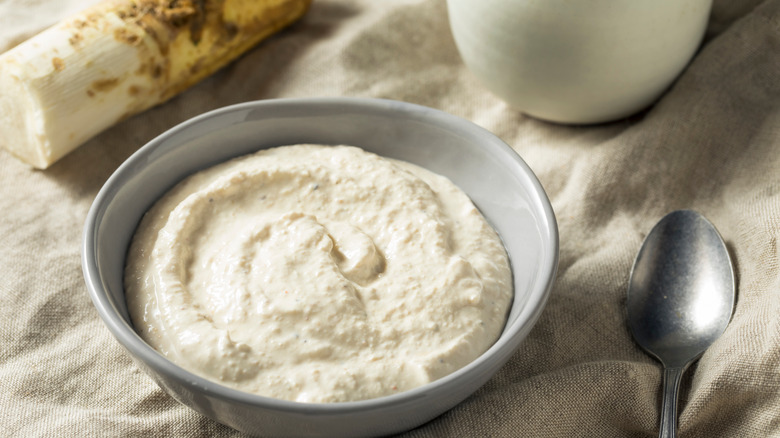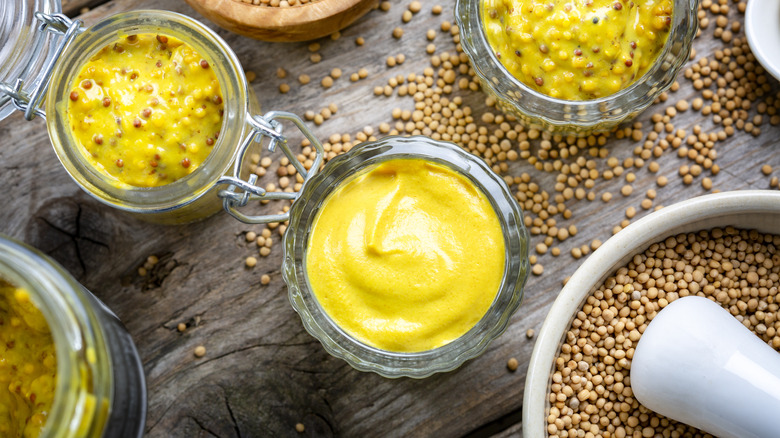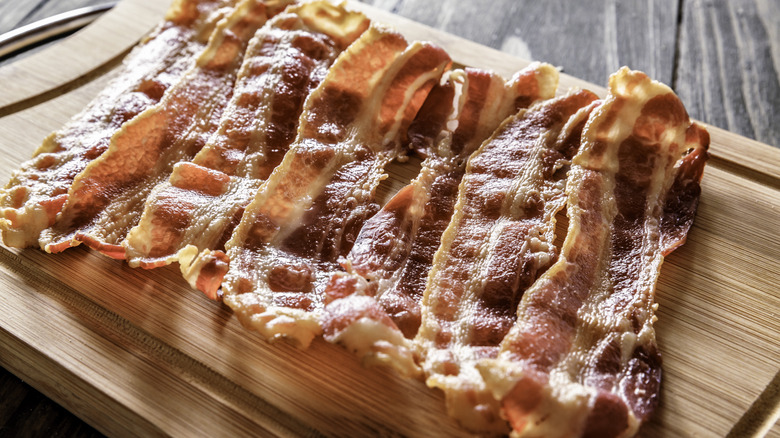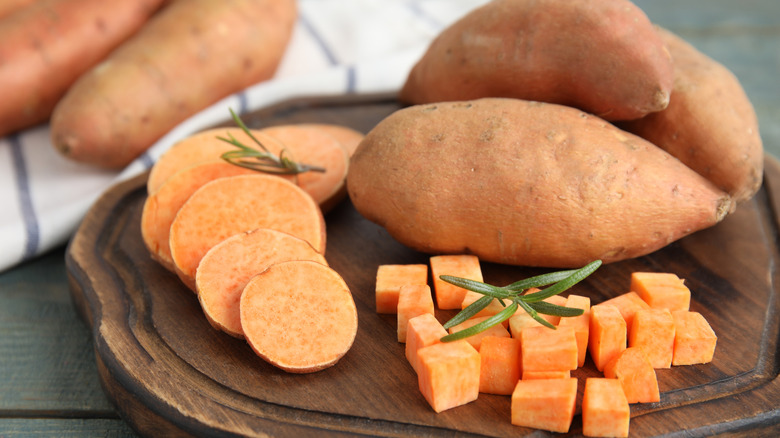10 Ingredients That Will Seriously Upgrade Corned Beef And Cabbage
Brisket, chopped cabbage, carrots, peppercorn, potatoes. Many of us already know the basic ingredients for the traditional, quintessential meal of Saint Patrick's Day: corned beef and cabbage. The hearty meat and vegetable dish was developed by some of the earliest Irish immigrants to the United States. The corned in the title comes from the method in which the red meat was cured with big grains, otherwise known as corns, of salt. However, the basic recipe for the holiday meal we recognize today was an improvisation. Back in Ireland, Irish bacon had been the typical protein of choice when throwing together earlier versions of the meal. Since corned beef was cheaper and more prevalent in their new American home, the immigrants adapted the recipe and combined the relatively new meat with roasted veggies to create a different — yet just as delicious — take on the nostalgic meal from their country of origin.
So don't be afraid to take a tip from the Irish ancestors this St. Paddy's Day. It is possible (dare we say, even encouraged) to switch up the traditional and expected. Whether it be an extreme ingredient swap or something as simple as the addition of a basic spice, there are many ways in which you can elevate your celebratory Irish entree this March. From beer to bacon to vegan meat, here are 10 ingredients with the potential to seriously upgrade your corned beef and cabbage.
1. Guinness
Guinness feels synonymous with Ireland, don't you think? A dry stout with a sometimes surprising untold truth, it has its origins in a pub in Dublin in the 1700s, one sip of the dark beer has the power to transport drinkers to the misty green island itself. But what many don't realize is that while the powerful, bold flavor of Guinness makes it a perfect beverage for sipping in a dimly lit pub, it's also a perfect braising liquid for meats — including the corned beef you throw in your slow cooker come St. Paddy's Day.
This holiday, don't be afraid to find a good recipe, grab a bottle of the beloved stout, and pour it into the slow cooker over your brisket. Though you may find yourself nervous thinking about the results that the powerful flavor and high alcohol content of the beer might yield, never fear. The alcohol will largely (though technically not entirely — that's a common cooking myth) cook out over hours of simmering.
In addition, the intense, bitter taste for which Guinness is known will level out to an appropriate measure, infiltrating the flesh of the meat and creating a just-right depth of flavor guaranteed to make you and your guests' taste buds sing. Add a fresh from the fridge, chilled Guinness on the side, and boom: you have a winning plate on your hands. All that remains is to sit down and enjoy it.
2. Soda
No, we aren't talking about soda bread (although a side of the loaf that is commonly baked in March could certainly be considered a necessary accompaniment to your plateful of corned beef and cabbage). We are instead talking about the concept of soda — as in Coca-Cola, Dr Pepper, root beer, or even Mountain Dew if you're feeling daring. These can all act as the braising liquid for the slow-cooked beef portion of your upcoming entree.
Sure, using something like Coke as a liquid cooking base might sound a bit bizarre at first, but hear us out. Soda, just like a nice dry red wine, makes for a brilliant tenderizer of meats. This is due to its naturally high acidity, which can easily give many forms of beef, whether it's brisket or barbecue, the coveted, melt-in-your-mouth tenderness that everyone's hoping to find when they slice into their cut after a long day of braising.
In addition to a deliciously smooth texture, the sweetness of a drink such as Dr Pepper can lend your meat a much richer and more complex flavor profile as it cooks down. Better flavor and moistness? We're not sure it gets any better than that. So, consider grabbing a can of Coke from the pantry and embracing a soft drink slow cooker recipe this Saint Patrick's Day.
3. Honey
To many minds, honey is nature's miracle ingredient. Sweeter than standard table sugar, the all-natural substance produced by the beloved honey bee comes with a slew of health benefits and a whirlwind of saccharine flavor (though it can also raise your blood sugar if you eat honey every day). But if you thought only the taste of oatmeal, peanut butter toast, or hot tea could be enhanced by the nigh-magical golden sticky treasure, you thought wrong. As it turns out, honey can be an incredible addition to your corned beef and cabbage in the form of a delectable finishing glaze.
If you're oven-baking your corned beef and veggies this year, a slightly sweeter take on the traditionally savory Irish dish can be achieved through a simple mixture of honey, brown sugar, ginger, and a few additions to create a glaze that can be spooned over the meat and vegetables after they are placed in a baking dish or roasting rack. The result? A mouth-watering amplification of the already sweet carrots, as well as the infiltration of an exciting new flavor into the potatoes and the effortless enhancement of the natural meaty flavor — all thanks to the honey bee's glorious golden contribution. Don't hesitate; look up a recipe and invite the sweetness onto your plate this St. Paddy's Day.
4. Rice
Who says you can't draw inspiration from other cultures when planning your Irish-themed meal? Although the classic potatoes and meat combination is the most well-known and often prepared variant of corned beef and cabbage, it doesn't mean that other innovative takes drawing on ingredients from other countries can't be whipped up, too. One way to make this traditional Irish dish less traditional — yet still reminiscent of the original — is by involving a carbohydrate other than diced potatoes. That's right: we're talking about rice.
With this simple swap, you can create a unique, inspired take on a classic that can take on dozens of different flavor profiles. Want to throw a Caribbean-esque twist in your St. Paddy's Day dining experience? Try using a base of rice, diced peppers, and some spices for a more zingy corned beef and cabbage. What about the addition of soy sauce and ginger to create a more Asian or Hawaiian-infused flavor? The possibilities are practically endless — all you have to do is pull out the rice cooker and let your creativity soar.
5. Seitan
Who says vegans have to miss out on all the Saint Patrick's Day fun? With the number of consumers choosing to avoid meat and animal byproducts increasing, so too is the ingenuity surrounding many recipes and dishes we may not have ever considered to be made meat-free. One of these, believe it or not, is Irish corned beef and cabbage. Though the presence of red meat is blatantly obvious in the traditional meal, it can be very easily replaced thanks to a beloved and popular vegan product called seitan.
Seitan, which is sometimes nicknamed wheat meat, is a protein-packed base made from vital wheat gluten that takes on a hearty texture with a chewiness similar to chicken strips or mushrooms. It has become one of the most commonly used vegan alternatives out there, often taking the place of bread or meats in traditional recipes. However, because of the presence of gluten, this won't work for anyone with a gluten intolerance or celiac disease.
Those who follow an animal-free diet will be happy to know that seitan can also swoop in and take the place of corned beef in the popular St. Paddy's Day recipe. Using a tasty broth and a strong simmer, a few chunks of seitan will easily take on the flavor and familiar texture of brisket — saving the day for celebrating Saint Patrick's Day vegans everywhere.
6. Brussels sprouts
As the name of the dish suggests, cabbage is the quintessential vegetable in corned beef and cabbage. But if you're just not digging the idea of the same old chopped cabbage at the center of the table this upcoming holiday, don't fret. There is a way to harness the familiar flavor of the traditional veggie while simultaneously introducing some textural variance through a quick and easy ingredient swap.
Brussels sprouts are part of the same cruciferous vegetable family as cabbage — making the two easily interchangeable when one is feeling the need for something new in their St. Paddy's dinner. Instead of chopping chunks out of a full-sized head of cabbage, slice some Brussels sprouts (which look like miniaturized versions of cabbage) length-wise and roast them in the oven on a sheet pan.
The major difference will be that prepared Brussels sprouts will end up crunchier than cabbage typically does, as the thin outer leaves roast and shrivel easily. Case closed. Bring on the Brussels sprouts!
7. Horseradish
Horseradish, a root vegetable harvested and used to make the strongly flavored white condiment many of us often spread on sandwiches for a bit of a kick, is an incredibly versatile ingredient. It's a rather fiery member of the brassica family, which includes cabbage and mustard. It can be added to deviled eggs, mixed in with bloody Marys, or become the star of a uniquely flavored hummus. But what if it also became the prize ingredient of your corned beef and cabbage entree this season?
Whether it's mixed with breadcrumbs to create a crust for the outside of your brisket or poured in liquid form over your chopped vegetables before roasting, horseradish definitely has its place in a corned beef and cabbage dinner. The heat of the veggie spread naturally complements and evens out the fatty richness of the braised meat, for one. It can also take the bland right out of a heaping pile of basic steamed carrots, potatoes, and chopped greens. So what are you waiting for? Grab a jar of the good stuff and research how to best utilize it in your yearly St. Paddy's Day feast.
8. Mustard
Let's face it: corned beef and hash in its traditional state could be considered a bit one note. But boredom when it comes to a dish with such rich historical roots is simply unacceptable. The classic salted beef and vegetable meal deserves to be enjoyed by those eating it, to give the meal the respect that it deserves. Sometimes, a simple bit of elevation is all it takes to keep the excitement alive for the St. Paddy's Day celebrations. Perhaps one of the easiest ways to do this is to add a good spicy mustard into the mix.
The tangy, earthy flavor of mustard makes for a natural pairing with the more subtle tones of traditional corned beef and cabbage, which — given its delicate flavor profile — can take on the strength of the yellow condiment's flavor quite nicely. There are many different ways in which you can utilize the zingy additive in your dish, such as whipping up a sauce to be drizzled upon serving or creating a glaze to be brushed over the meat prior to cooking, to name a few. The possibilities are practically endless, but no matter which method you select, using mustard on your St. Paddy's Day dish is guaranteed to make you feel the luck of the Irish when digging in.
9. Bacon
These days, it's practically considered a scientific maxim that everything tastes better with bacon. From restaurants whipping up bacon burgers left and right, to waffle recipes across the internet calling for bacon bits to be folded into the batter, to bartenders mixing cocktails with candied strips of the stuff, the popular pork product seems to do nothing but amplify the taste of every dish or beverage it touches. And as you've likely already surmised, corned beef and cabbage is no exception to this rule.
Whether roasted in the oven or slow-cooked all day, the addition of fatty bacon can amp up the texture and flavor of your corned beef and cabbage. Try chopping it up while it's raw and simmering the bits of bacon in the slow cooker along with the brisket. If you're oven-roasting, consider wrapping the raw slab of red meat with strips of thinly sliced pork or sprinkling cut-up bits atop your bed of vegetables to harness all of that heavenly pork flavor. Whichever way you do it, we can't imagine there's a universe in which you would regret adding the glorious flavor of salty bacon to your meal. It's basically science, after all.
10. Sweet potatoes
Generally speaking, a traditional corned beef and cabbage recipe typically calls for either white or red potatoes as its starchy carbohydrate element. Perhaps this is because these types of potatoes are much more prevalent in the cooler climate of Ireland — and so the Irish immigrants who developed the dish were understandably more familiar with these spud variants.
Sweet potatoes, however, flourish in warm or tropical environments, which made them an excellent candidate for growing in the American South after they were brought over from Africa via the transatlantic slave trade. Seeing how sweet potatoes have become an American staple in the intervening centuries, there's no rule saying you can't swap them out in your entree this year.
In fact, doing so could produce a more interesting, rich, and sweeter take on the original. Given that sweet potatoes are significantly less starchy than potatoes, you'll likely end up with a pleasant change of pace in terms of texture, as well.
